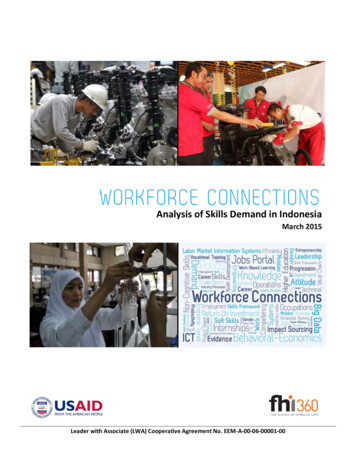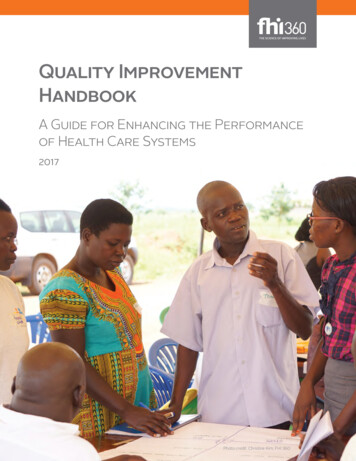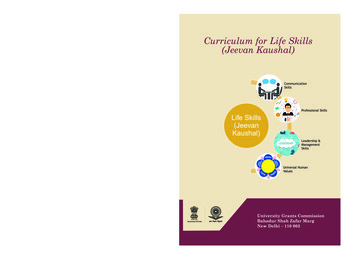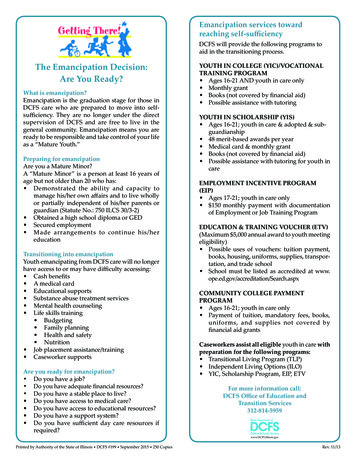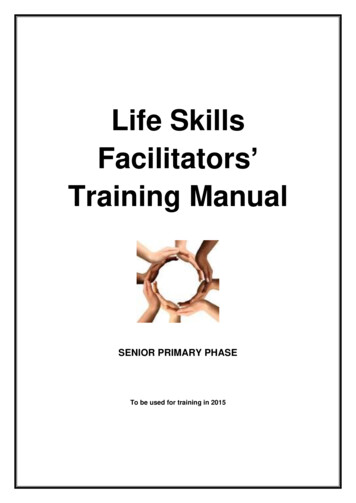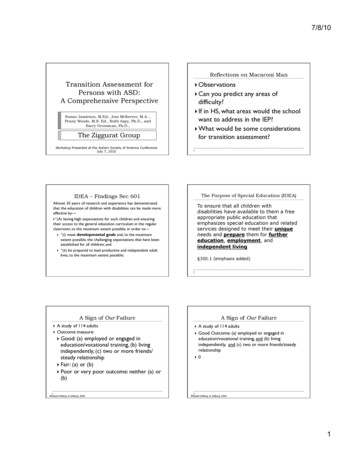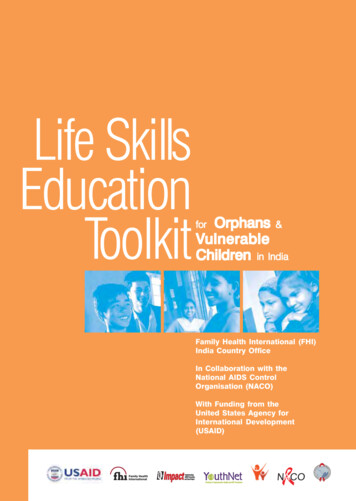
Transcription
Life SkillsEducationToolkitOrphans &VulnerableChildren in IndiaforFamily Health International (FHI)India Country OfficeIn Collaboration with theNational AIDS ControlOrganisation (NACO)With Funding from theUnited States Agency forInternational Development(USAID)
In July 2011, FHI became FHI 360.FHI 360 is a nonprofit human development organization dedicated to improving lives in lasting ways byadvancing integrated, locally driven solutions. Our staff includes experts in health, education, nutrition,environment, economic development, civil society, gender, youth, research and technology – creating aunique mix of capabilities to address today’s interrelated development challenges. FHI 360 serves morethan 60 countries, all 50 U.S. states and all U.S. territories.Visit us at www.fhi360.org.
AcknowledgmentsDr. Sonal Zaveri, FHI consultant led the process of putting together the Life Skills Education Toolkit.Anita Khemka took the photographs during visits to USAID/FHI projects. The National OVC TaskForce including the Ministry of Women and Child Development (MoWCD), National AIDS ControlOrganisation (NACO), UNICEF and the India HIV/AIDS Alliance, reviewed the LSE Toolkit and gavevaluable comments. The staff and children of 30 USAID/FHI projects contributed their ideas andtime in the initial development and then pre-testing of the LSE toolkit.Suggested CitationLife Skills Education Toolkit for Orphans & Vulnerable Children in India, India – (October 2007)ISBN 1-933702-19-2Any parts of this toolkit may be photocopied or adapted to meet local needs without permission fromUSAID/FHI or IMPACT, provided that the source is acknowledged, the parts copied are distributed free ofcost and credit is given to USAID/FHI/IMPACT. USAID/FHI/IMPACT would appreciate receiving a copy of anymaterials in which parts of this toolkit are used.“This resource is funded by the President’s Emergency Plan for AIDS Relief through the U. S. Agency forInternational Development (USAID), under the terms Cooperative Agreement # HRN-A00-97-00017-00 toFamily Health International. The opinions expressed herein are those of the author(s) and do not necessarilyreflect the views of Family Health International or the U.S. Agency for International Development.”
India Country Office16, Sunder NagarNew Delhi 110 003, IndiaTel: (91 11) 4150 7444/7555Fax: (91 11) 2435 8366www.fhi.orgPREFACEThis Life Skills Education (LSE) Toolkit takes a child participatory approach and deals withthe “whole child” - feelings, beliefs, development needs - and equips children with life skillsrequired to make safe choices and lead healthy lifestyles. This toolkit is unique in aiming todevelop essential life skills to manage and cope with risk situations in HIV/AIDS and to copewith difficult circumstances related to care and support including loss. The child-friendlyparticipatory approach uses active learning methods including games, role plays, debates,brainstorming, drama, story telling, group learning, case studies and poster making.An extensive consultation process was undertaken across India with participation of childreninfected, affected and vulnerable to HIV, parents and guardians, communities, NGOs, NACO,SACS, counselors, psychologists and psychiatrists, and Departments of Health and FamilyWelfare in the central government and six states of Andhra Pradesh, Delhi, Maharashtra,Manipur, Nagaland and Tamil Nadu, and one union territory of Pondicherry.With funding from the United States Agency for International Development (USAID), underthe IMPACT and YouthNet projects, Family Health International (FHI) has partnered with 37local NGOs to reach out to 50,000 orphans and vulnerable children (OVC) in India withHIV/AIDS prevention and care and support activities. All the partners were involved indifferent stages of the toolkit development and field-tested the LSE kit before finalization.The children and NGO partners have provided important insights on inclusion of the mostappropriate activities, the process of making the toolkit more user-friendly, and feedback onthe positive responses seen in children undergoing LSE.The Ministry of Health and Family Welfare (MoHFW) through the National AIDS ControlOrganization (NACO) and State AIDS Control Societies (SACS) has participated in variousconsultation workshops on the LSE toolkit. The participation has facilitated the effort tofollow the national priorities in addressing the HIV/AIDS prevention and care and supportneeds of OVC. FHI is thankful to the Ministry and NACO for providing the valuabledirection. The support of the Ministry of Women and Child Development (MoWCD) hasbeen essential to ensure that the LSE toolkit is line with national policies and we are thankfulto the Ministry for their endorsement and to all members of the National OVC Taskforceincluding UNICEF and the India HIV/AIDS Alliance for their review.FHI appreciates the funding support from USAID for the LSE development process throughto finalization, the support of NACO, SACS and MoWCD, and the tremendous input ofenergy, time and commitment from the NGO partners to the development of the LSE toolkit.Finally and especially, we wish to thank and acknowledge the thousands of children whosepriorities, needs and aspirations are reflected in the LSE Toolkit.Kathleen KayCountry DirectorFamily Health International
Hkkjr ljdkjefgyk ,oa cky fodkl ea ky;'kkL h Hkou] ubZ fnYyh & 110 001GOVERNMENT OF INDIAMINISTRY OF WOMEN & CHILD DEVELOPMENTSHASTRI BHAWAN, NEW DELHI-110 001lR;eso t;rsWebsite : http://www.wcd.nic.inDEEPA JAIN SINGHSECRETARYTel. : 23383586, Telefax : 23381495E-mail : secy.wcd@nic.inFebruary 23, 2007MESSAGEHIV/AIDS is one of the major public health problems in India. The HIVepidemic has spread to all sections of society including men, women and children.Children living with HIV/AIDS often find themselves in circumstances where theyhave to care for their elders and siblings. These children need support at all stagesof their lives.Life Skills Education (LSE) is an important activity which enables children toidentify the problems in their lives, think of probable solutions and practice them.The LSE toolkit developed by USAID/FHI discusses the various situations related toHIV risk through child partcipatory activites. It also discusses the situation ofchildren living with HIV/AIDS and affected families.I think this would be a useful tool for the Ministry in its HIV/AIDS programme.I commend the efforts of USAID/FHI in developing this document.(DEEPA JAIN SINGH)
lR;eso t;rsK. Sujatha RaoAdditional Secretary & Director GeneralN a t i o n a l A I D S C o n t r o l O r g a n i s a t i o n , M i n i s t r y o f H e a l t h a n d F a m i l y We l f a r e , G o v e r n m e n t o f I n d i a11th May, 2007MESSAGEThe various stakeholders involved in the formulation of National AIDS ControlProgramme (NACP) Phase III have highlighted an urgent need to strategize and developrelevant tools for addressing HIV prevention, care and support needs of childreninfected and affected by HIV/AIDS in the country. The Life skills Education (LSE)toolkit developed by Family Health International fills an important gap in providingvarious dimensions of appropriate communication skill for peer educators, teachers andcounselors working with children.This toolkit has been developed with the aim of reaching out to children andadolescents with essential life skills to enable them to off-set the risk of acquiringSexually Transmitted Infections and HIV, as well as coping with HIV infection of selfand their family members. I am told the toolkit has been used in the USAID-supportedIMPACT projects in six States, Andhra Pradesh, Delhi, Maharashtra, Manipur,Nagaland and Tamil Nadu, with encouraging results. The evidence from their areas is atestimony to the need for developing such learning material for the disadvantagedchildren.This toolkit will be useful for NGOs and caregivers in their field areas forundertaking child-freindly learning sessions and orienting children to core skills forleading healthy and safe lives. This innovative and practical resource material wouldmake learning an enjoyable experience for the children coming from disadvantagedbackgrounds. Teachers and care givers who work in such settings would find the toolkita more meaningful way of creatively engaging the children and working constructivelywith them in dealing with their situation.I am confident this toolkit will be used by a variety of stakeholders in thecountry (health and related Government agencies and local, national and internationalNGOs) in effectively reaching out to orphans, vulnerable, infected and affected childrenby HIV/AIDS.(K. Sujatha Rao)9th Floor Chandralok Building, 36 Janpath, New Delhi - 110001 Phone: 011-23325331 Fax: 011-23731746E-mail: asdg@nacoindia.orgviuh ,pvkbZoh voLFkk tkusa( fudVre ljdkjh vLirky esa eq¶r lykg o tkap ik,WKnow yor HIV status; go to the nearest Government Hospital for free Voluntary Counselling and Testing
INDIAFOREWORDLife Skills Education is an important component of HIV/AIDS prevention, care and treatmentinterventions with children and adolescents. Family Health International (FHI) has developed aLife Skills Education (LSE) toolkit under the IMPACT project and supported by the UnitedState Agency for International Development (USAID). The toolkit aims to address the growingneed for strengthening delivery of HIV prevention messages to adolescent learners and teachers.The toolkit is informed by rich experiences from 30 pilot projects that were initiated under theIMPACT project in six states and one union territory in India. Teaching children infected oraffected by HIV/AIDS requires innovative approaches for critical skills such as coping andcaring skills. Through the toolkit, teachers, school administrators and parents will get theneccessary skills in facilitating a learning environment that will help prepare children andadolescents strengthen their response to the various challenges in life.FHI has taken the initiative of developing this toolkit with contributions made by variousnational and international agencies at different stages of development. I would like to thank theNational OVC Task Force including UNICEF, Minstry of Women and Child Development,NACO and India HIV/AIDS Alliance for reviewing the toolkit.The third phase of the National AIDS Control Program (2006-2011) envisages a scale-up ofinterventions addressing children and adolescents in India. I hope the toolkit would find wideacceptance as a support to the national program and to build a stronger future of the children inIndia.Robert ClayDirectorOffice of Population, Health and NutritionUSAID/IndiaU.S. Agency for International DevelopmentAmercian EmbassyChanakyapuriNew Delhi 110 021Tel : 91-11-24198000Fax : 91-11-24198612www.usaid.gov/in
Table of ContentsPreface . iiiMessage by Secretary, MOWCD . vMessage by Additional Secretary, NACO . viiForeword . ixAbbreviations .xiiiPART ONEIntroduction to the Life Skills Education Toolkit . 1-7PART TWOFacilitator’s Guide . 1-60PART THREEDesign of the Modules . 1Module Plan Overview . 4Module One – Getting Started . 1-12Module Two – Knowing Myself . 1-20Module Three – Communication . 1-20Module Four – Relationships . 1-32Module Five – Decision-Making . 1-28Module Six – Coping with Emotions . 1-36Module Seven – Growing Up . 1-20Module Eight – Preventing and Living with HIV . 1-28Module Nine – Substance Use . 1-20Module Ten – Reaching My Goals: Energizers, Warm-ups and Relaxation . 1-16PART FOUR: BACKGROUND READINGInformation Sheet 1: Children’s Rights and HIV/AIDS . 15Information Sheet 2: HIV/AIDS . 19Information Sheet 3: Sexually Transmitted Infections . 21Information Sheet 4: Preventing Sexual Transmission of HIV Through the ABC Approach . 23Information Sheet 5: HIV Information Needs of Children . 27Information Sheet 6: Helping Children to Cope with Grief . 33Information Sheet 7: Additional Warm-ups and Energizers . 35References for Exercises/Activities . 39Useful Resources/References . 41
RTSTITOTUNAIDSUNICEFUSAIDWHOWINSYWCAAbstinence, Be Faithful and Use CondomsAcquired Immunodeficiency SyndromeAntiretroviralCommitted Communities Development TrustThe Center for Development and Population ActivitiesCommunity Health Education SocietyCatholic Relief ServicesChild to Child ApproachFocus Group DiscussionFamily Health InternationalHuman Immunodeficiency VirusInjecting Drug UserImplementing AIDS Prevention and Care ProjectKey Informant InterviewLife Skills EducationNational AIDS Control OrganizationNon Governmental OrganizationOral Rehydration SaltOrphans and Vulnerable ChildrenProject Concern InternationalPeer EducatorPeople Living with HIV/AIDSSociety for All Round DevelopmentSocial Educational and Economic Development SocietySociety for Development Research and TrainingSexually Transmitted InfectionTraining of TrainersJoint United National Program on HIV/AIDSThe United Nation’s Children’s FundUnited States Agency for International DevelopmentWorld Health OrganizationWomen’s InitiativesYoung Women’s Christian Association
IntroductionsPart OneINTRODUCTION TOTHE LIFE SKILLSEDUCATION TOOLKIT
LIFE SKILLS EDUCATION TOOLKITFOR ORPHANS AND VULNERABLE CHILDREN IN INDIAIntroduction to theLife Skills Education ToolkitFAMILY HEALTH INTERNATIONAL (FHI), INDIA COUNTRY OFFICE
ContentsPart One: Introduction to the Toolkit Why was the toolkit Developed?How was the toolkit Developed?What is in the toolkit?Who will find the toolkit useful?“This resource is funded by the President’s Emergency Plan for AIDS Relief through the U. S. Agency forInternational Development (USAID), under the terms Cooperative Agreement # HRN-A00-97-00017-00 toFamily Health International. The opinions expressed herein are those of the author(s) and do not necessarilyreflect the views of Family Health International or the U.S. Agency for International Development.”
LIFE SKILLS EDUCATION TOOLKIT FOR ORPHANS AND VULNERABLE CHILDREN IN INDIA PART ONE: Introduction to theLife Skills Education ToolkitThe “Making one Billion Count” report of the United Nations Population Fund cautionsthat the world is now home to the largest generation of adolescents in history. Of theglobal population counting 6.3 billion people, 1.2 billion are between the ages of10 and 19—with many facing the risks of disease, unwanted pregnancy and poverty.HIV/AIDS has emerged as one of the greatest threats to adolescents; this age group now accounts forhalf of all new cases of the disease. Alarmingly, every 14 seconds a young person between the ages of15 and 24 becomes infected. In addition, AIDS related deaths have orphaned 13 million childrenunder the age of 15. In sub-Saharan Africa, home to youth with the greatest numbers of HIV/AIDS,nearly 8.6 million people have HIV/AIDS—two-thirds of whom are female. In South Asia, 1.1 millionyouths are infected—62 percent are female. The rate of new infections is also growing rapidly inmany other countries including India. Discussing sexual behavior is a taboo in many countries; as aresult, many young people do not know how to protect themselves.If these trends continue, the next generation of adults will face greater poverty and difficultsocioeconomic circumstances. The report estimates the economic benefit of a single avertedHIV/AIDS infection is 34,600 for a poor country, and the social benefits are even greater. Moreinvestment must be made in youth-friendly services, family planning and education programs toaddress the reproductive health issues of young people. Their educational and health status,readiness to take on adult roles and responsibilities, and the support they receive from theirfamilies, communities and governments will determine their own future and the future oftheir countries.Source: United Nations Population Fund, State of the World’s Population Report, 2003Young people hold the promise of our future. Working with and helping young people have always been apriority across time and cultures. The HIV/AIDS epidemic has challenged us in exceptional ways to find themeans to protect and empower our young people to help them become happy, healthy adults. Life skillsoffer an approach to contribute to the well being of our young and help them meet life’s many challenges.1
2 PART ONE: INTRODUCTION TO THE LIFE SKILLS EDUCATION TOOLKITWhy was the Life Skills EducationToolkit developed?Family Health International (FHI), throughfunding from the United States Agency forInternational Development (USAID), works with 37projects in India reaching approximately 50,000orphans and vulnerable children (OVC).Organizations working with OVC expressed a needto develop a toolkit to provide essential skills forchildren in the project areas to prevent them fromacquiring STIs/HIV/AIDS and to help them copewith HIV infection. Existing Life skills educationmanuals were found to deal only with preventiveskills; more was needed to provide criticalinformation on the coping skills needed for youthaffected by and infected with HIV/AIDS. Toaccomplish this goal, FHI commissioned aconsultant to develop this Life Skills EducationToolkit.In the Indian context, vulnerable children are thosewho are at risk of acquiring HIV and may not beHIV infected or affected. The Life Skills EducationToolkit was developed to address the risk of HIV forvulnerable children; and children infected andaffected by HIV/AIDS. A variety of programs forchildren from diverse settings were involved in thecreation of the Toolkit. These included programesthat worked with children living in shelter homes,the streets, communities, and urban and rural redlight areas. Children involved included those livingwith parents with HIV or orphaned by AIDS,children of sex workers, and those frommarginalized communities or migrant populations.For the purpose of this document ‘vulnerablechildren’; and children infected and affected byHIV/AIDS are referred to as OVC.THE NEEDS ARE GREAT—CHILDREN ARE NOW ATTHE CENTER OF THE EPIDEMIC1. It is estimated that more than 50 percent of allnew infections affect young people betweenthe ages of 15 and 29.2. In low prevalence areas, there is an urgentneed to target young people to prevent HIVand address risk behavior.3. In places with high rates of HIV infection,there is an urgent need to address orphansand vulnerable children. Children areespecially vulnerable when parents are livingwith HIV or have died of AIDS.
LIFE SKILLS EDUCATION TOOLKIT FOR ORPHANS AND VULNERABLE CHILDREN IN INDIA DEFINING THE YOUNG The terms “adolescents,” “youth,” and “young people” are used differently in differentsocieties. These categories are often associatedwith varying roles, responsibilities and agesdepending on the local context.Key life events—marriage, sexual debut (firstsexual intercourse), employment,childbearing, acceptance in adultorganizations and political participation—also occur at different times between andwithin societies.National programs and policies often makedifferent distinctions among these categoriesas well. In India, for example, the country’sYouth Policy includes people up to the ageof 35. Commonly used definitions acrossdemographic, policy and social contexts include:– Adolescents: 10-19 years of age (earlyadolescence, 10-1; late adolescence, 15-19) ;– Youth: 15-24 years of age;– Young people: 10-24 years of age;– Child: From the ages of birth throughadolescence. As per the Juvenile Justice Act2000, “child” is defined as an individualbelow 18 years of age;– Vulnerable Child: A child living in ahousehold with a chronically ill parent/caregiver in a high-risk setting due to HIVprevalence or proximity to high-riskbehaviors. In the Indian context,“vulnerable children” are those who are atrisk of acquiring HIV infection; and– Orphan: A child who has lost one orboth parents.This document uses USAID definitions in its Orphanand Vulnerable Children projects and young people andchildren are used synonymously.CHILDREN NEED BOTH HIV PREVENTION ANDCARE AND SUPPORTHIV/AIDS programs must address the diversevulnerabilities of children, including: Children of sex workers and othermarginalized communities, such as ragpickers and street children, who are inexploitive situations and are especiallyvulnerable to HIV; Girls who are increasingly at risk because ofmyths surrounding sexuality and STIs/HIV,such as the belief that if a man has sex with avirgin girl, he can be cured of STIs/HIV; Media messages particularlycommunicated through adult programsand literature like movies and magazinesthat glamorize alcohol, sex and richlifestyles tempting young people tosuccumb to potentially risky situations; Substance use among young people,which makes them vulnerable to riskybehavior and HIV; Young boys and girls who are unaware ofreproductive health issues and safe sexpractices may experiment with unprotectedsex and expose themselves to STIs/HIV; and Children who are caregivers ofHIV-affected parents, and thus haveexperienced trauma and the loss ofchildhood, may also be infected by HIV.Over the years better understanding of the HIVepidemic has emphasized the need to sensitize andeducate service providers to respond urgently andmore effectively to the needs of orphans andchildren who are vulnerable, infected and affectedby HIV/AIDS.3
4 PART ONE: INTRODUCTION TO THE LIFE SKILLS EDUCATION TOOLKITNEED FOR LIFE SKILLS EDUCATIONRESOURCES THAT ADDRESS BOTH HIVPREVENTION AND CARE AND SUPPORT ISSUESWestern countries need to include ways in whichboth children and the community can contributeto the learning of life skills.This Life Skills Education Toolkit addresses differentgroups of children in different contexts for bothHIV prevention and care and support. The Toolkitcan be used by projects that aim to:This Life Skills Education Toolkit provides aframework and methodology for children toparticipate in the learning of life skills and for adultsto facilitate this process in the context of thesocieties in which they live, be it a slum community,a village, a street or an institution. Prevent HIV infection; Manage and cope with risky situationsrelated to HIV; and Help cope with issues related to HIVinfection and care and support.The Life Skills Education sessions encourageschildren to acquire psychosocial skills, enablingthem to acquire the following abilities: Understand sexual issues and sexuality inorder to reduce their vulnerability to HIV;NEED FOR LIFE SKILLS EDUCATIONRESOURCES TO PROMOTE CHILDREN’SPARTICIPATION Cope effectively with risky situations;Life skills education manuals generally provide abag of activities to pick and choose from. Somemanuals are more instructional and didactic intheir approach rather than anchored in theprinciples of children’s participation. Availablemanuals do not provide a conceptual frameworkfor how young people participate and learn safebehavior. For example, in many cultures familyand community are important players in decisionmaking processes. Social relationships in thesecultures influence decisions. However, in Westernsocieties, decision-making are often linear,individualistic and rational.1 Programs in non- Learn how to help and support other children.1 Practice safe sex behavior to reduce HIVrisks; andChildren can acquire these skills only if they areable to learn and practice them in a supportiveenvironment of peers and family. This toolkitbuilds on many decades of program experiencethat promote children’s participation andchildren’s rights. The Life Skills approachadvocated in this toolkit helps children learn,recognize and integrate lessons learned inlearning centers through real-life situations. Inthis way, children are able to practice new, safeand healthy behaviors and build confidence intheir day-to-day lives.For an excellent discussion on emerging communication frameworks for HIV/AIDS see UNAIDS/Penn State Project,“Communication Framework for HIV/AIDS,” 1999 and Richard Parker and Peter Aggleton, “HIV and AIDS related stigma anddiscrimination: a conceptual framework and implications for action,” Social Science and Medicine 57 (2003) 13-24, www.elsevier.com/locate/socscimed.
LIFE SKILLS EDUCATION TOOLKIT FOR ORPHANS AND VULNERABLE CHILDREN IN INDIA How was the Toolkit Developed?The development of the toolkit, which took a yearto complete, included an assessment of the needsfor life skills in OVC programs in India.Organizations2 that were working on HIV/AIDS indifferent states in India participated throughquestionnaires and workshops that assessed whylife skills were needed, how children could beinvolved in the learning process and whatbehavioral changes in children were expected fromthe Life Skills Education Program. Results wereused to help define the goals and objectives of theLife Skills Education Program. The contents of thetoolkit were developed after an exhaustive reviewof literature that included children’s participation,child rights, reproductive health, the psychosocialdevelopment of children and Life skills educationmanuals from India and other countries. Selectedactivities from these manuals were adapted andnew ones were developed and integrated to addressthe goals of the Life Skills Education Program.Field-based organizations working on OVC issuesfrom different parts of India participated in2conceptualizing, pilot testing, reviewing andadapting the toolkit. The toolkit has undergoneseveral revisions with feedback from the field,and will continue to be enriched and revised withexperience.A skill-building workshop in child participatorymethodologies and life skills was held for allparticipating organizations in the developmentof the Toolkit. On-site support during pilottesting was provided to six organizations and anexhaustive activity-by-activity feedback and reviewwas given to all organizations. Contents of the Lifeskills education toolkit working draft were sharedat skill building workshops. Feedback was receivedthrough various channels: e-group sharedexperiences, onsite visits were made, and partnerNGOs contributed by participating in the fieldtesting. After six months of pilot testing, a nationallevel workshop was held to synthesize the learningand incorporate feedback and experiences. Thisedition of the Life Skills Education Toolkitincorporates these experiences.CCDT and Prerana in Mumbai: SARD, YWCA, PCI, Salaam Baalak Trust in Delhi, CHES, Positive living project (Namakkal) inTamil Nadu, SFDRT in pondicherry; SEEDS, WINS and World Vision in Andhra Pradesh and DSSS (CRS Manipur).5
6 PART ONE: INTRODUCTION TO THE LIFE SKILLS EDUCATION TOOLKITWhat is in the Tookit?The Toolkit is a comprehensive package comprisedof a Facilitator’s Guide, Life skills educationModules, Information Sheets and a list ofResources for further reading and reference.The Facilitator’s Guide provides a rationale forbehavior change through child participation, howchildren can participate, what facilitation andsupport is required by significant adults and thewider
India Country Office 16, Sunder Nagar New Delhi 110 003, India Tel: (91 11) 4150 7444/7555 Fax: (91 11) 2435 8366 www.fhi.org PREFACE This Life Skills Education (LSE) To
